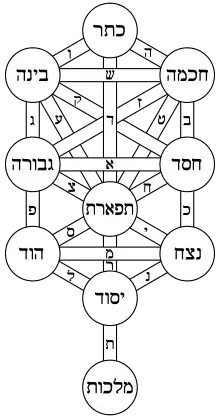| Part of a series on |
| Kabbalah |
|---|
 |
Gilgul (also Gilgul neshamot or Gilgulei HaNeshamot; Heb. גלגול הנשמות, Plural: גלגולים Gilgulim) is a concept of reincarnation or "transmigration of souls"[1] in Kabbalistic esoteric mysticism. In Hebrew, the word gilgul means "cycle" or "wheel" and neshamot is the plural for "souls." Souls are seen to cycle through lives or incarnations, being attached to different human bodies over time. Which body they associate with depends on their particular task in the physical world, spiritual levels of the bodies of predecessors and so on. The concept relates to the wider processes of history in Kabbalah, involving cosmic Tikkun (Messianic rectification), and the historical dynamic of ascending Lights and descending Vessels from generation to generation.
The esoteric explanations of gilgul were articulated in Jewish mysticism by Isaac Luria in the 16th century, as part of the metaphysical purpose of Creation.
History in Jewish thought
Reincarnation is an esoteric belief within many streams of modern Judaism, but is not an essential tenet of traditional Judaism. It is not mentioned in traditional classical sources such as the Hebrew Bible, the classical rabbinic works (Mishnah and Talmud), or Maimonides' 13 principles of faith. Kabbalah (Jewish mysticism), however, teaches a belief in gilgul, transmigration of souls, and hence the belief is universal in Hasidic Judaism, which regards the Kabbalah as sacred and authoritative.
Among well-known rabbis who rejected the idea of reincarnation are Saadia Gaon, David Kimhi, Hasdai Crescas, Jedaiah ben Abraham Bedersi (early 14th century), Joseph Albo, Abraham ibn Daud and Leon of Modena. Among the Geonim, Hai Gaon argued with Saadia Gaon in favour of gilgulim.
Rabbis who believed in the idea of reincarnation include, from Medieval times: the mystical leaders Nahmanides and Bahya ben Asher; from the 16th-century: Levi ibn Habib, and from the mystical school of Safed, Shlomo Halevi Alkabetz, Isaac Luria, and his exponent Hayyim ben Joseph Vital; and from the 18th-century: the founder of Hasidic Judaism, the Baal Shem Tov, later Hasidic Masters, and the Lithuanian Jewish Orthodox leader and Kabbalist the Vilna Gaon; and - amongst others - from the 19th/20th-century: Yosef Hayyim author of Ben Ish Hai.
With the 16th-century rational systemisation of Cordoveran Kabbalah by Alkabetz, and the subsequent new paradigm of Lurianic Kabbalah by Luria, Kabbalah replaced rationalism as the mainstream traditional Jewish theology, both in scholarly circles and in the popular imagination. Isaac Luria taught new explanations of the process of gilgul and identification of the reincarnations of historic Jewish figures, which were compiled by Hayyim ben Joseph Vital in his Shaar HaGilgulim.
See also
In Judaism:
For comparison with other religions:
References
- ↑ Trachtenberg, Joshua (13 February 2004) [Originally published 1939]. "Glossary of Hebrew Terms". Jewish Magic and Superstition. Philadelphia: University of Pennsylvania Press (published 2004). p. 333. ISBN 9780812218626.
External links
- Jewish view of reincarnation
- Ask the Rabbi - aish.com Archived 2016-03-04 at the Wayback Machine
- "Gilgul Neshamot - Reincarnation of Souls", essay on gilgul by Rav Avraham Brandwein
- Sefer Nishmath Hayyim by Menasseh Ben Israel Archived 2010-02-21 at the Wayback Machine